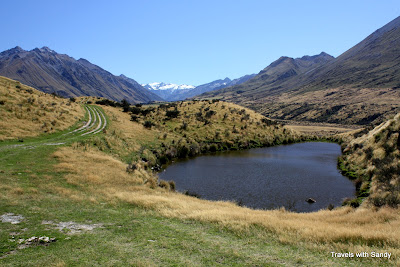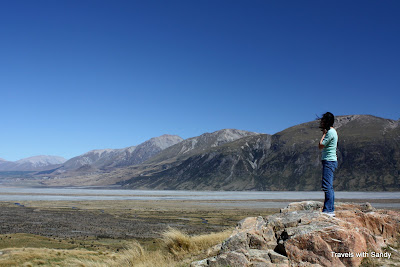Although I like to think of myself as an adventurous, independent traveler, sometimes I just want to be a tourist. I am not afraid to admit it. One of the reasons that I wanted to fly across the world to New Zealand was to go to Middle Earth. It is widely known that Peter Jackson’s Academy Award winning Lord of the Rings movies (LOTR) were filmed all over New Zealand. Thus, one of my stipulations in coming to New Zealand was that I would go on a full-on Lord of the Rings tour.

Visiting Edoras on top of Mt. Sunday. New Zealand is Middle Earth.
While growing up in New Zealand, Peter Jackson imagined the landscapes of his home to be part of Tolkien’s Middle Earth. As a result, bringing Tolkien’s literary works to life through his films in his native NZ was a particularly special experience for Jackson, although it was no easy feat. Many of the film locations were in remote areas that are hard to access. This, along with the plan to make all three movies in the trilogy at once, made things particularly challenging. However, Jackson has remarked that these challenges also had the positive effect of making the actors more able to empathize with their characters.
Since there was so much to see in New Zealand outside of LOTR, Charles and I decided we would only take one guided LOTR tour. We ultimately went with a tour of Edoras, the capital of Rohan (the horse people), because it was one of the most spectacular natural locations in the movie and you can only visit it on a tour since it’s on private property. We wanted to fully immerse ourselves in Middle Earth, and I can say with absolute confidence that we achieved this goal. Edoras was filmed on Mt. Sunday, near Mt. Potts sheep station, which is located about 2 hours southwest of Christchurch. Ironically, the land of Rohan was filmed in the area known as Erehwon, New Zealand. Erehwon was the name of a fictitious country in a book by Samuel Butler, and is also Nowhere spelled backwards. How fitting.
When we arrived at the edge of Mt. Potts, it was clear that we had entered Middle Earth. Peering over the edge of a hill, we saw Edoras on a rocky plateau in the middle of flat plains surrounded by mountains with a silver stream running through. It is just as Tolkien described Edoras in Lord of the Rings.

The kingdom of Rohan spread out before us in Erehwon, NZ.
You can see Mt. Sunday/Edoras in this photo if you look closely. It is the big rock about halfway up and to the right in this photo.
As our four wheel drive vehicle drove towards the rocky plateau on which Edoras once stood in the filming, I was filled with anticipation. The kingdom of Rohan was the most stunning part of the movie, in my opinion, so my expectations were high. I need not have worried. Seeing it in real life was even better.

Mt. Sunday, home of Edoras.

Photo of Edoras from the filming of the movie (from Hassle Free Tours).
My photos have not captured a fraction of the scale of this setting. Imagine seeing this while being surrounded by miles of flat, grassy lands that are surrounded by mountains. It was one of the most beautiful places I have ever set my eyes on.
To get to Mt. Sunday, our SUV had to traverse a beautiful river and then drive up a steep gravel road, which only went halfway up. From then on, we walked right into Edoras.

The most beautiful place I’ve ever been. Mt. Sunday.
Once we got to the top, we had a 360 degree view of Rohan. It was simply breathtaking. From Edoras, we could see the Misty Mountains and Helm’s Deep. It was also very very very windy. Click on any of these photos for a closer view.

Panoramic view from the top of Mt. Sunday.

View of the Misty Mountains from Edoras.

View of Helm’s Deep (top left quadrant of photo).
At this point, the tour participants were allowed to indulge their LOTR fantasies. Our tourguide showed us pictures from the movie so that we could better picture the set. The movie set took months to construct, but they only filmed for about a week. After filming ended, per their contract, the film company had to restore everything, including the exact location of every tussolk (bush), back to its original condition and location.

Me on Edoras/Mt. Sunday pretending to be Eowyn.

Eowyn in front of Meduseld, Edoras.
Note: Image copyrighted by New Line Cinema. The use of the above image is for informational purposes only and qualifies as fair use. The inclusion of this photo in this post adds significantly to the post because it shows Edoras in its full glory. Source: Google Images.

Our wonderful tourguide kindly indulged us and put up the flag of Rohan.
Following our hike up to Edoras, we reluctantly left and had lunch (provided by the tour company). On the car ride back, the tourguide played the behind the scenes shows from the LOTR DVD box set, which was a perfect way to end our tour of Middle Earth.
Even if you are not a LOTR fan, Erehwon is a place worth visiting. The scenery was epic and truly stunning. It was… dare I say it…LEGENDARY. It is one of those places where when you go, you figure a place this beautiful is sure to be easy to photograph. But after taking some shots, you get depressed because the photos just cannot capture a fraction of what it really looks like. I will remember this day and this beauty the rest of my life.
TIPS: If you are at all interested in seeing any of the LOTR movie locations in New Zealand, I recommend purchasing “The Lord of the Rings Location Guidebook” by Ian Brodie. It lists all of the movie locations by region and includes GPS coordinates and photos. While I found it difficult to pinpoint the exact location of the locations much of the time, it is the only source out there for this subject matter. There are two versions of this book – the small compact version and the huge coffee table version. I bought the small version so it would be easy to carry with me. Although this book is difficult to obtain outside of NZ, rest assured that it is available in every bookstore in NZ.
DETAILS on the TOUR:
We toured Edoras with Hassle Free Tours. We were picked up in Christchurch at around 9 AM from our B&B and dropped off around 6 PM. We had a fantastic experience with this company from booking to the tour itself. They provide a well informed tourguide/driver, lunch, interesting commentary, and of course access to Mt. Sunday, which is on private property. On the way to Mt. Sunday, the tour provides a rest stop, including rest rooms. There are also rest rooms where you eat lunch. Overall, we were completely satisfied with this tour. Great service and stunning scenery!
For more information, see Hassle Free Tours’ website:
http://www.hasslefree.co.nz/pages/18/lord-of-the-rings-tour.htm




Recent Comments